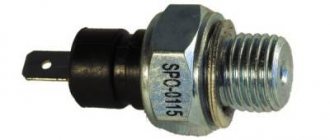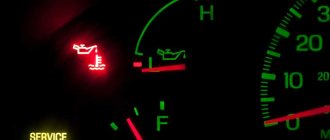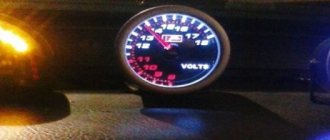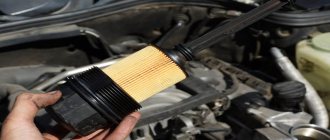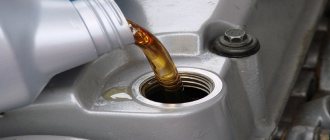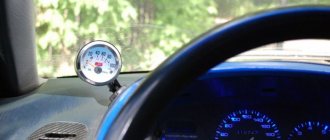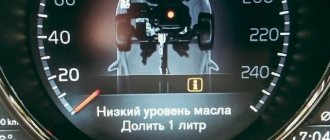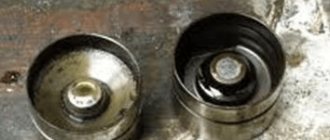If you have lost oil pressure in a VAZ-2106 car, the control light is constantly on or flashes periodically, then you need to urgently take measures to fix the problem. Otherwise, there is a very high risk of engine failure, the repair of which will be quite expensive. Why does blood pressure decrease and what to do in this situation?
Why did the VAZ oil pressure drop?
The need for a technical inspection arises when the VAZ oil pressure is lost. Often a breakdown occurs while driving or after an overnight stay. To determine its cause, you will need to examine the “iron horse”. There is no point in waiting for the problem to resolve itself. As the oil gauge continues to light, the vehicle's technical condition will gradually deteriorate.
Formation of a fault
Absence or insufficient oil pressure leads to rapid wear of engine parts. Even under light loads, the motor elements do not receive the required amount of lubricant. There are many reasons for such a malfunction, but most often it is the deformation of the oil pan that is to blame. This can happen even with a new car, so there is no need to refuse preventive examinations.
It is not difficult to damage the mentioned unit while crossing artificial uneven surfaces or when driving on a bumpy road. A few hits on the oil pan are enough for the engine to develop a problem with oil pressure. Further developments depend on the severity of the damage:
Regardless of the degree of breakdown, experienced drivers focus on an important aspect. Under no circumstances should the lubricant pressure level in the system be allowed to drop to 0. As soon as the arrow crosses the indicated value, irreversible changes will begin in the engine. If a breakdown occurs while driving, you must stop immediately and turn off the engine.
The same should be done if, as a result of a breakdown, the oil pressure level in the system has increased many times over. Otherwise, its excess amount will come out of all holes. Excessive lubrication will not benefit engine components.
Fault Diagnosis
Constant monitoring of the engine condition will help reduce the likelihood of a sudden breakdown even when driving carefully.
A sensor on the dashboard can determine what pressure is in the system. It is constantly in the driver's field of vision, otherwise expensive repairs cannot be avoided. At the same time, its meaning should not mislead the owner of the “iron horse”.
It happens that a short circuit in the sensor lamp circuit leads to incorrect readings. It's easy to check. It is enough to connect the wire from the sensor directly to the engine (to ground). If after this manipulation the light does not go out, you need to replace it. An extinguished light will indicate that the oil pressure in the system has indeed lost.
Further troubleshooting involves inspecting the oil sensor itself. Ideally, the device should be in oil; if this is not the case, you should continue to look for the problem below. The oil filter valve located below often malfunctions. The problem is eliminated by replacing the gadget, the cost of which is low. If this does not help get to the bottom of the truth, they continue to look for the problem at idle speed of the car.
The pan and oil receiver are inspected for mechanical damage. It would be a good idea to inspect the oil pickup ring. It should not show signs of abrasions or mechanical damage. The list of possible malfunctions that lead to incorrect display of the oil level in the system ends with a breakdown of the pressure reducing valve. If you have a classic or premium version of a VAZ, a similar malfunction may occur. Eliminated during engine overhaul.
A drop in the lubricant level in the system is a dangerous breakdown that can damage individual engine components or the entire engine. That is why you should constantly pay attention to the oil level sensor. At the slightest deviation, a preventive examination is carried out.
Main causes of malfunction
Structurally, the lubrication system is quite simple, but its functioning can be affected by other engine elements. Therefore, there are quite a few reasons why the warning light comes on:
- Oil pressure sensor malfunction;
- Damage to the sensor-indicator light circuit;
- Exhaustion of lubricant life or its inadequacy;
- Low oil level;
- Clogged oil filter element, malfunction of its bypass valve;
- Clogged oil intake;
- Oil pump wear;
- Reducing valve jammed;
- Critical wear of engine components (crankshaft and timing gear);
- Penetration of other technical liquids into the pan.
Note that these are only the main and general causes of a drop in oil pressure, which are typical for any engine. But there are also reasons that occur only on certain car models.
Engine oil pressure - what should it be?
Engine oil pressure is used to ensure that lubricating components can penetrate all parts of the engine and ensure its normal functioning for the entire period of oil operation. The internal combustion engine oil pressure is created by an oil pump, which is driven by the crankshaft through a complex gear system. We will try to figure out how to check the oil pressure, what it should be, and also learn about the reasons for the loss of pressure and how to eliminate them.
What should the oil pressure be and how to check it
Oil pressure is a very important value, because the quality of lubrication of engine parts will depend on it. If the pressure is insufficient, the oil will not be able to get into small holes, and if there is excess pressure, it will squeeze out the seals and cause increased leakage. That is why it is important to know and be able to maintain oil pressure at the proper level.
For example, for a VAZ 2107 engine, standard values are set at which the oil pressure is within normal limits. The normal level starts from 0.2 kgf/cm2 . At the same time, the contact contacts of the oil pressure sensor are open and the lamp indicating insufficient oil pressure does not light up. When the engine is warmed up, the oil pressure can reach 4.5 kgf/cm2 . Moreover, these values are typical only for idle speed. As their number increases, the pressure increases in direct proportion.
As for checking the oil pressure, only VAZ 2106 cars of their classic family are lucky here, since they have a sensor for monitoring oil pressure. There is simply no such device in the VAZ 2107 panel. Therefore, we will measure pressure directly on the engine itself.
To do this, you will need a working pointer from the car. One of the pointer contacts must be connected to ground, and the other two to positive, which must be taken from the car’s ignition switch. The last wire goes to the sensor contact, which is not connected to ground. Start the engine and check the gauge readings. If everything is connected correctly, the device will give you accurate values.
Of course, there are devices that are simply screwed in instead of the old sensor and, after starting the engine, give more accurate readings, but the previous method has long been time-tested and has helped out more than one car enthusiast.
What to do if there is no oil pressure
If the oil pressure disappears, this is not a good sign. It is not difficult to find out about this - the corresponding red lamp will light up on the instrument panel. In this case, you need to immediately turn off the engine and figure out the reasons why the oil pressure lost?
The required amount of pressure inside the engine is created by a special oil pump, which is driven by the engine crankshaft. The tightness of the system is ensured by a system of oil seals and seals. Based on this, the reasons for the decrease in oil pressure can be identified in the list below.
Causes of low blood pressure
- Oil pump malfunction . It manifests itself as a mechanical component, such as jamming or breakage of individual elements or its clogging. The fact is that such a pump has very thin tubes for oil circulation, which can easily become clogged due to small foreign particles.
- Violation of the tightness of the system is the most “capricious” malfunction, which is quite difficult to identify, but possible. First of all, this concerns the oil seal, which suddenly began to leak and leak a certain amount of oil out. As the oil level drops, the pressure created inside also decreases. The most visible malfunction associated with low pressure is a broken engine sump, which happens when driving carelessly on “bad” roads.
Looking for a fault
Until the cause of the oil pressure light coming on is eliminated, it is better not to operate the car. To solve the problem, you can contact a service center, or identify and fix the problem yourself, saving on service station services. Much depends on the make of the car.
If there are no visible causes of the problem - there are no leaks, and the level is normal, we carry out diagnostics.
Self-testing is carried out “from simple to complex.” The main working element of the system is the lubricant. Therefore, we check it first.
If the lubricant is not changed on time (every 8-10 thousand km), perhaps the oil has exhausted its resource and has become very liquid, which is why the oil pump is not able to pump it in the required quantity, creating the necessary pressure.
In cases where the lubricant has been changed relatively recently, make sure that the tolerance and specification of the engine oil that was filled in matches the car’s engine.
How to increase oil pressure in a VAZ 2106 engine
Oil pressure sensor VAZ 2106
The operating principle of the oil pressure sensor is based on the property of deformation of an elastic membrane under the influence of liquid (oil) or gas pressure. Almost all pressure sensors are based on this property of materials. The amount of membrane shift is mechanically transmitted to a variable resistor (rheostat), the change in its resistance is recorded by the vehicle’s equipment and displayed on the pressure gauge.
Connection
1. Connect the “orange wire” to the positive of the ignition switch.
2. “White wire”, to the dimensions wire,
3. We throw the “white and black” wire to ground.
4. Gray wire to the emergency oil pressure sensor (which we had, standard)
5. We connect the “dark gray and black” wire to the oil pressure sensor (indicator) we installed.
Replacement
To replace the oil sensor, no special knowledge of plumbing is required, and this work is a simple technological process. We stock up on a standard set of plumbing tools and begin repair work. The sequence of technological operations is as follows:
Disconnect the oil pressure sensor and the wiring that goes with it.
Using a wrench, unscrew the device.
We dismantle the product and install the updated device.
How to check
As a rule, anything related to pressure is usually checked using a pressure gauge. Screw in the pressure gauge instead of the sensor and start the engine. At idle speed, the pressure gauge should show a pressure of 0.65 kgf/cm2 or more, we can conclude that the pressure is OK, but the pressure sensor is not, so an immediate replacement of the oil pressure sensor is necessary.
If you don’t have a pressure gauge on hand and somewhere in the middle of the highway your oil pressure light comes on, you can check the pressure sensor in another way. To do this, you need to unscrew the sensor and turn the starter without starting the engine. If, during rotation by the starter, oil splashes or pours from the socket where the sensor was installed, we also conclude that the sensor is faulty and requires replacement.
Does not work
If the emergency oil pressure sensor works (the light on the panel goes out after the engine starts), measure the voltage on the device. Its absence will indicate a malfunction of the oil pressure sensor; its presence will indicate a malfunction of the device. First, look at the contact on the sensor.
When the oil pressure suddenly drops to zero and the light comes on, you should not panic. It’s possible that the engine is running normally, but there are some problems with the oil sensor. In any case, it is best to stop the car and turn off the engine.
First of all, after a forced stop, you need to open the hood and inspect the engine compartment. If oil leaks are not visible, you should check the level of lubricating fluid in the engine. A lack of engine oil can cause low pressure. If the garage or service station is close, you can slowly get there at your own pace.
When the inspection did not answer the question of why the light came on, it is better to get home by tugboat.
In a quiet environment at home or in the garage, it is necessary to diagnose the oil pressure sensor. To do this, you will have to find a pressure gauge with a suitable measurement range. Please note that the connecting thread of the BAZ-2106 sensor is designated M14x1.5. Accordingly, the testing device must have the same parameters or it will require an additional adapter.
To remove the oil sensor you will need an open-end wrench. The work is performed with the engine not running. Now a pressure gauge is mounted in its place. All that remains is to start the engine and see the real pressure parameters in the oil line. To increase engine speed and look at the upper pressure limits, you will have to ask for help from neighbors or relatives. If all measurements are normal, it is necessary to replace the oil sensor.
Replacing the VAZ 2106 oil pump: what is it done for
Oil pump of a VAZ 2106 car
In a running engine, friction forces arise, to overcome which some of the engine power is spent. In addition, friction can cause overheating and wear of parts.
Reducing the negative impact of friction forces and improving the performance of moving parts is achieved by:
- Improving the quality of processing of rubbing surfaces of all elements of the assembly.
- Using rolling bearings.
- The most effective way is to introduce a layer of lubricant between the rubbing surfaces.
The oil film replaces the friction of the mating surfaces of the parts with the friction between layers of lubricant. Other than this oil:
- Cools parts.
- Removes from the friction zone solid particles formed during wear of rubbing surfaces.
- Protects parts from corrosion.
- Seals any gaps.
The VAZ 2106 uses a different lubrication system:
- The most stressed parts are lubricated under pressure.
- Splashing and oil that flows from the gaps formed between the mating parts.
Engine lubrication for VAZ 2106
The photo of the engine of a VAZ 2106 car shows that under pressure from the gear oil pump, position 8, lubricant is obtained:
- Crankshaft bearings:
- connecting rod, through the supply channel position 4;
- indigenous, through channel 3.
- Bearings and camshaft cams along the oil supply channel, position 22.
- Bearings for the drive shaft of the oil pump and ignition distributor, through channel 12.
Components affecting the operation of the lubrication system
But as already noted, other components and mechanisms can affect the functioning of this system.
Such mechanisms primarily include the KShM. If the engine has worked a significant life without major repairs, then wear of the elements of this mechanism will negatively affect the operation of the lubrication system as a whole.
Due to the large gaps between the crankshaft bearings and journals, there is a strong loss of oil pressure, which is why the lamp comes on. In this case, the problem can only be solved by a major overhaul.
The lubricant itself can aggravate the problem of component wear. The exhaustion of the resource or the mismatch of the oil brand can cause it to become very liquid after heating, which is why the pump cannot create pressure. You should pay attention to the condition of the oil if the lamp constantly comes on after the engine warms up.
Filling with thicker oil allows you to delay the overhaul or eliminate the “hot” signal, but this measure is temporary - eventually the engine will have to be repaired.
How to increase engine compression
How to increase compression in an engine is a question that motorists often ask themselves, whose cars are far from new and have driven well over 100 thousand kilometers. It is the compression of the engine that speaks about its health and how reliable it is in operation.
- What is compression?
- Signs of low compression in the engine.
- Reasons for a drop in engine compression
- How to identify an engine compression problem
- Engine compression restoration
- Synthetic lubricants
- How to protect your engine from loss of compression
- All in your hands
